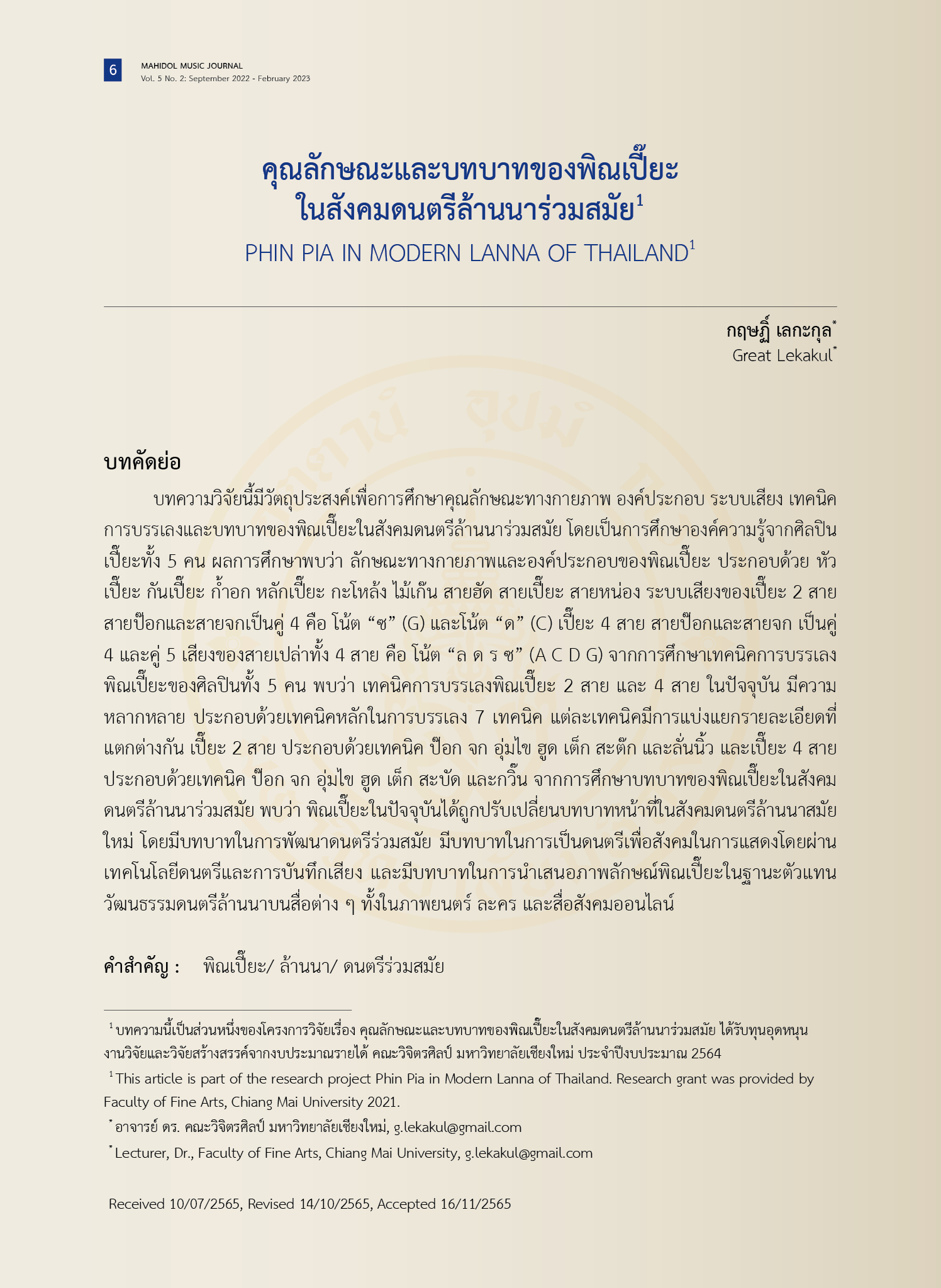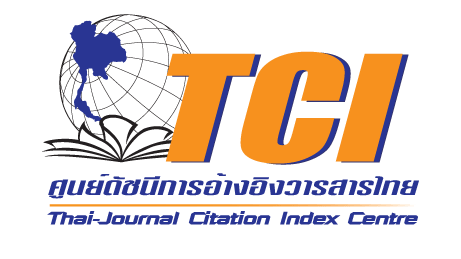PHIN PIA IN MODERN LANNA OF THAILAND
Keywords:
Phin Pia, Lanna, Contemporary MusicAbstract
Phin Pia in Modern Lanna of Thailand focuses on the characteristics of phin pia musical instrument in relation to its musical techniques and role in modern Lanna society. This research focuses on five famous phin pia musicians from Northern Thailand the results of the study are as follows: The structure and composition of phin pia comprises pia head, pole, tuning pegs, connector, stick, resonator, tuning loops, and strings. The two-sting phia pia includes pok and jog strings which both strings are tuned as an interval forth (G and C), while four-string phin pia includes one pok string and another three jok strings that are tuned as intervals fourth and fifth respectively (A C D G). Phin pia illustrates the variety of musical techniques. Two-string phin pia has seven musical techniques including pok, jok, um-khai, hoot, tek, satok, and lannail, while four-string phin pia also has seven musical techniques comprising pok, jok, um-khai, hoot, tek, sabut, and kwin. Exploring the role of phin pia in modern lanna society shows the change in and development of the role of phin pia in contemporary Lanna culture. It illustrates phin pia has a key role in developing Lanna contemporary music, representing itself as music for society by participating in live music performance with the support of music technology, and acting as a representative of Lanna music and identity through media.
References
ณรงค์ สมิทธิธรรม, บก. ระลึกถึงบุญมา ไชยมะโน พุทธศักราช 2465-2548. กรุงเทพฯ: สํานักงานวัฒนธรรมแห่งชาติ กระทรวงวัฒนธรรม, 2548.
ธีรพงศ์ ฉลาด. “ระเบียบวิธีการบรรเลงพิณเปี๊ยะ 2 สาย ของครูรักเกียรติ ปัญญายศ.” วิทยานิพนธ์ระดับปริญญามหาบัณฑิต, จุฬาลงกรณ์มหาวิทยาลัย, 2551.
ประสิทธิ์ เลียวสิริพงศ์. "เปี๊ยะ: เด็งพันเมาแห่งล้านนาไทย." ใน แปง โนจา ผู้มีผลงานดีเด่นทางด้านวัฒนธรรม สาขาศิลปะการแสดง (ดนตรีพื้นบ้าน-พิณเปี๊ยะ), 74-77. เชียงราย : สำนักงานคณะกรรมการวัฒนธรรมแห่งชาติ, 2538.
พิพัฒน์พงศ์ มาศิริ. “แนวคิดในการศึกษาอัตลักษณ์ทางดนตรี.” MFU Connexion Journal of Humanities and Social Sciences ปีที่ 5, ฉบับที่ 1 (มกราคม-มิถุนายน 2559): 146-256.
พิพัฒน์พงศ์ มาศิริ. “พาทย์ก๊อง : วงปี่พาทย์ล้านนาในบริบทสังคมเชียงใหม่ปัจจุบัน.” วิทยานิพนธ์ระดับปริญญามหาบัณฑิต, มหาวิทยาลัยแม่ฟ้าหลวง, 2552.
รัชวิทย์ มุสิการุณ. “การศึกษาวิเคราะห์บทเพลงสําหรับ “เปี๊ยะ.” วิทยานิพนธ์ระดับปริญญามหาบัณฑิต, มหาวิทยาลัยมหิดล, 2547.
สงกรานต์ สมจันทร์. “ชีวิตและงานของเจอรัลด์ ไดค์ กับดนตรีล้านนา.” ใน ดนตรีล้านนา ปิ๊กบ้าน : Gerald P. Dyck กับการศึกษามานุษยวิทยาดนตรีในดนตรีล้านนา, 19-26. เชียงใหม่ : หอจดหมายเหตุดนตรีล้านนา เจอรัลด์ ไดค์ มหาวิทยาลัยราชภัฏเชียงใหม่, 2559.
สุรสิงห์สำรวม ฉิมพะเนาว์. “การเล่นเปี๊ยะ : การส่งดนตรีจากดวงใจ.” ใน แปง โนจา ผู้มีผลงานดีเด่นทางด้านวัฒนธรรม สาขาศิลปะการแสดง (ดนตรีพื้นบ้าน-พิณเปี๊ยะ), 94-96. เชียงราย : สำนักงานคณะกรรมการวัฒนธรรมแห่งชาติ, 2538.
Boden, Margaret A. Dimensions of Creativity. United States of America: MIT Press, 1996.
Dyck, Gerald P. “Doing My Part to Save the Pin Pia (พิณเปี๊ยะ).” In Musical Journeys in Northern Thailand, 142-151. Assonet, MA: Minuteman Press of Fall River, 2009.
Dyck, Gerald P. “The Vanishing Phia: An Ethnomusicological Photo Story.” In Selected Reports in Ethnomusicology, edited by David Morton, 217-229. California: University of California Los Angeles, 1975.
Great Lekakul. “Prachan: Music, Competition, and Concept Fighting in Thai Culture.” Ph.D. diss., SOAS University of London, 2017.
McGraw, Andrew. “The Pia’s Subtle Sustain: Contemporary Ethnic Identity and the Revitalization of the Lanna 'Heart Harp'.” Asian Music 38, no. 2 (Summer-Autumn 2007): 115-142.
Nettl, Bruno. “The Continuity of Change: On People Changing Their Music.” In The Study of Ethnomusicology: Thirty-One Issues and Concepts, 272-281. Champaign: University of Illinois Press, 2005.
Shahriari, Andrew. “Lanna Music and Dance: Image and Identity in Northern Thailand.” Ph.D. diss., College of Fine and Professional Arts of Kent State University, 2001.

Downloads
Published
How to Cite
Issue
Section
License
Copyright (c) 2023 College of Music

This work is licensed under a Creative Commons Attribution-NonCommercial-NoDerivatives 4.0 International License.
The copyright of the article belongs to the author. Published articles represent the views of the authors. The editorial team neither necessarily agree with nor take any responsibility for the article.





